Related Research Articles

Yunnan is a province in Southwest China. The province spans approximately 394,000 square kilometres (152,000 sq mi) and has a population of 48.300 million. The capital of the province is Kunming, formerly also known as Yunnan. The province borders the Chinese provinces Guangxi, Guizhou, Sichuan, and the Tibet Autonomous Region, as well as the countries Vietnam, Laos, and Myanmar. Yunnan is China's fourth least developed province based on disposable income per capita in 2014.

Kunming is the capital and the largest city of Yunnan province—China's fourth least developed province based on disposable income per capita. Known as Yunnan-Fu until the 1920s, today it is a prefecture-level city and the political, economic, communications and cultural centre of the province as well as the seat of the provincial government. The headquarters of many of Yunnan's large businesses are in Kunming. It was important during World War II as a Chinese military center, American air base, and transport terminus for the Burma Road. Located in the middle of the Yunnan–Guizhou Plateau, Kunming is located at an altitude of 1,900 metres above sea level and at a latitude just north of the Tropic of Cancer. As of 2014, Kunming has a population of 6,626,000 with an urban population of 4,575,000, and is located at the northern edge of Dian Lake, surrounded by temples and lake-and-limestone hill landscapes.

Ruili is a county-level city of Dehong Prefecture, in the west of Yunnan province, People's Republic of China. It is a major border crossing between China and Myanmar, with the town of Muse located across the border.

Qujing is a prefecture-level city in the east of Yunnan province, China. It is an important industrial and commercial city, and is Yunnan's second largest city by comprehensive power, after Kunming. It is part of the Central Yunnan Metropolitan Region plan (滇中城市群规划). Qujing is located near Guizhou Province and Guangxi Zhuang Autonomous Region, so it was called "Key between Yunnan and Guizhou" (滇黔锁钥) and "Throat of Yunnan" (云南咽喉) in the past.
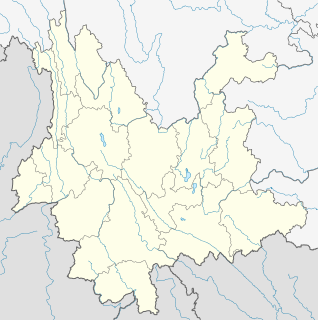
The Hekou Yao Autonomous County is an autonomous county in the southern part of the Yunnan province of China. It is part of the Honghe Hani and Yi Autonomous Prefecture and borders the northern Vietnamese city of Lào Cai. It was apparently known as Zhongcheng during the Tang dynasty.
The Kunming High-tech Industrial Development Zone is a state-level high-tech industrial zone established in 1992 in Northwest Kunming, Yunnan Province, China. It is administratively under Kunming Prefecture. It covers an area of 9 square kilometers. The zone is located in the northwest part of Kunming city, four kilometers from Kunming Railway Station and five kilometers from Kunming International Airport.
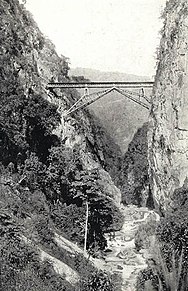
The Yunnan–Haiphong railway is an 855 km (531 mi) railway built by France during 1904–1910, connecting Haiphong, Vietnam with Kunming, Yunnan province, China. The section within China from Kunming to Hekou is known as the Kunming–Hekou railway, and is 466 km long. The section within Vietnam is 389 km (242 mi) long, and is known as the Hanoi–Lào Cai railway. The railway was built with 1,000 mm gauge due to the mountainous terrain along the route. Currently it is the only main line in China using 1,000 mmmetre gauge.

The transport infrastructure of Yunnan is served by numerous transport modes, and forms an integral part of the structure Yunnan Province and the Southwest of China. Yunnan is served by several civilian airports and a major highway and rail network. The province is served by a network of bus routes that radiates from the capital city, Kunming.

Muse is the capital town of Mu Se Township in northern Shan State, Myanmar. It is situated on the Shweli River, and is connected by a bridge and road to Ruili in Yunnan Province, China.

Wanding Town, also known as Wandingzhen and Wanting, is a frontier town in Ruili City, Dehong Prefecture, Yunnan Province, China.
Hekou Border Economic Cooperation Zone (HKBECZ) is a Chinese State Council-approved Industrial Park based in Hekou County, Honghe Prefecture, Yunnan, China, founded in 1993 and was established to promote trade between China and Vietnam. Transport links with Ho Chi Minh City and Hanoi, Vietnam include:
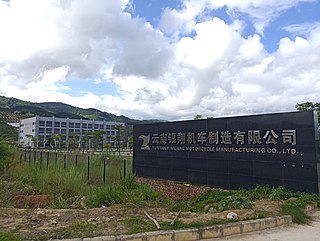
Ruili Border Economic Cooperation Zone (RLBECZ) is a Chinese State Council-approved Industrial Park based in Ruili City, Dehong Prefecture, Yunnan, China, founded in 1992 and was established to promote trade between China and Myanmar. The zone connects Ruili with Man-wing City.

Wanding Border Economic Cooperation Zone (WTBECZ) is a Chinese State Council-approved Industrial Park based in Wanding Town, Ruili City, Dehong Prefecture, Yunnan, China, founded in 1992 and was established to promote trade between China and Myanmar. The zone spans 6 km sq. and is focused on developing trading, processing, agriculture resources and tourism.

The Nanxi River, also known as the Nậm Thi River in Vietnamese or Namiti, is a tributary of the Red River located in China's Yunnan province. It is a border river of Lào Cai, Vietnam, and Hekou, China.
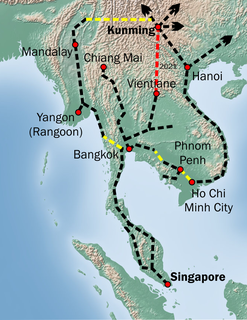
The Kunming–Singapore railway, increasingly called the Pan-Asia railway Network is a network of railways, being planned or under construction, that would connect China, Singapore and all the countries of mainland Southeast Asia. The concept originated with British and French imperialists, who sought to link the railways they had built in southwest China, Indochina and Malaya, but international conflicts in the 20th century kept regional railways fragmented. The idea was formally revived in October 2006 when 18 Asian and Eurasian countries signed the Trans-Asian railway Network Agreement, which designates the Kunming–Singapore railway as one of several planned trans-Asian railways.

The Dali–Ruili railway or Darui railway, is a single-track electrified railroad under construction in Yunnan Province of Southwest China. The line is slated to run 336.39 km (209 mi) from Dali in central Yunnan to Ruili in southwestern Yunnan on the border with Myanmar. The line traverses rugged terrain, and bridges and tunnels will account for 75% of the total track length, including the 36 km Gaoligongshan Tunnel through the Gaoligong Mountains. Construction began in May 2011 and was scheduled to take six years. However, this has been repeatedly delayed, and as of 2019 the railway is scheduled to open only in 2022. Cities and towns along route include Dali, Yangbi Yi Autonomous County, Yongping County, Baoshan, Mangshi and Ruili.

The Bangladesh, China, India and Myanmar Economic Corridor (BCIM) is an initiative connecting India and China through Myanmar and Bangladesh as a corridor.
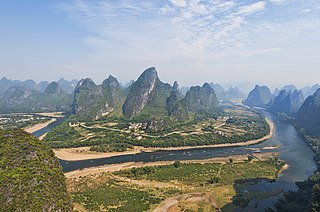
Guangxi, officially the Guangxi Zhuang Autonomous Region (GZAR), is an autonomous region of the People's Republic of China, located in South China and bordering Vietnam and the Gulf of Tonkin. Formerly a province, Guangxi became an autonomous region in 1958. Its current capital is Nanning.
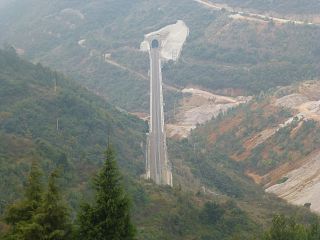
The Kunming–Yuxi–Hekou railway is a standard-gauge railway in Yunnan Province of China, linking the provincial capital Kunming with the town of Hekou on the Vietnamese border. Constructed in several stages between 1989 and 2014, the Kunming–Yuxi–Hekou railway has largely replaced the Chinese section of the old metre-gauge Kunming–Haiphong railway for normal passenger and cargo transportation. The line is electrified, but single-tracked over most of its length.
China-Myanmar Economic Corridor (CMEC) is a number of infrastructure projects supporting connectivity between Myanmar and China. It is an economic corridor of the Belt and Road Initiative.